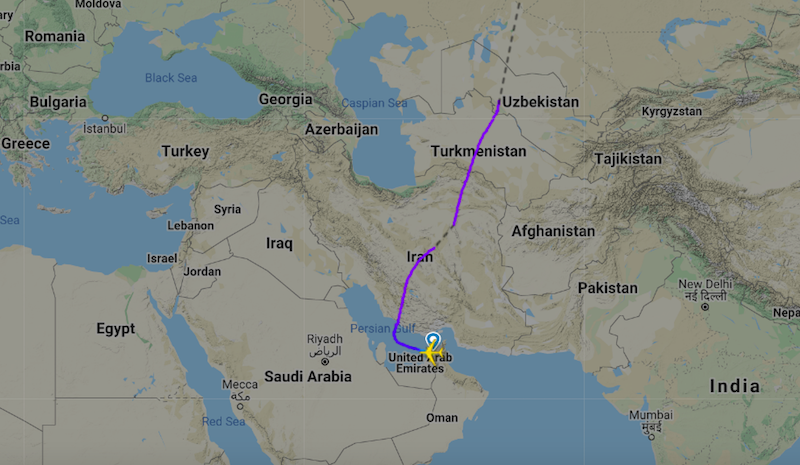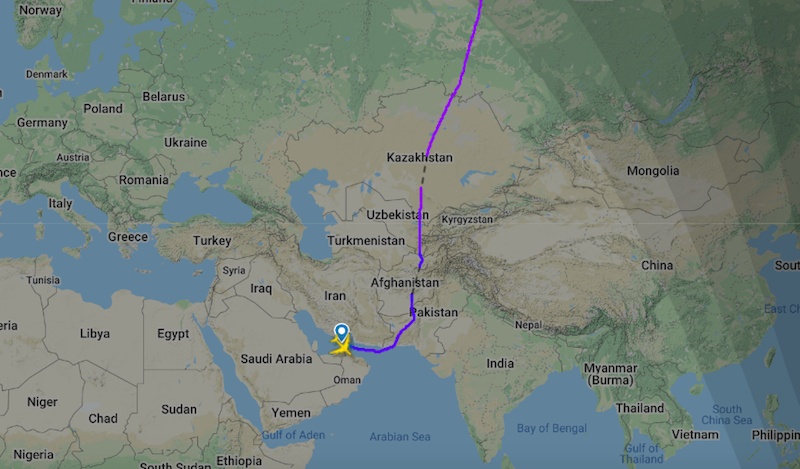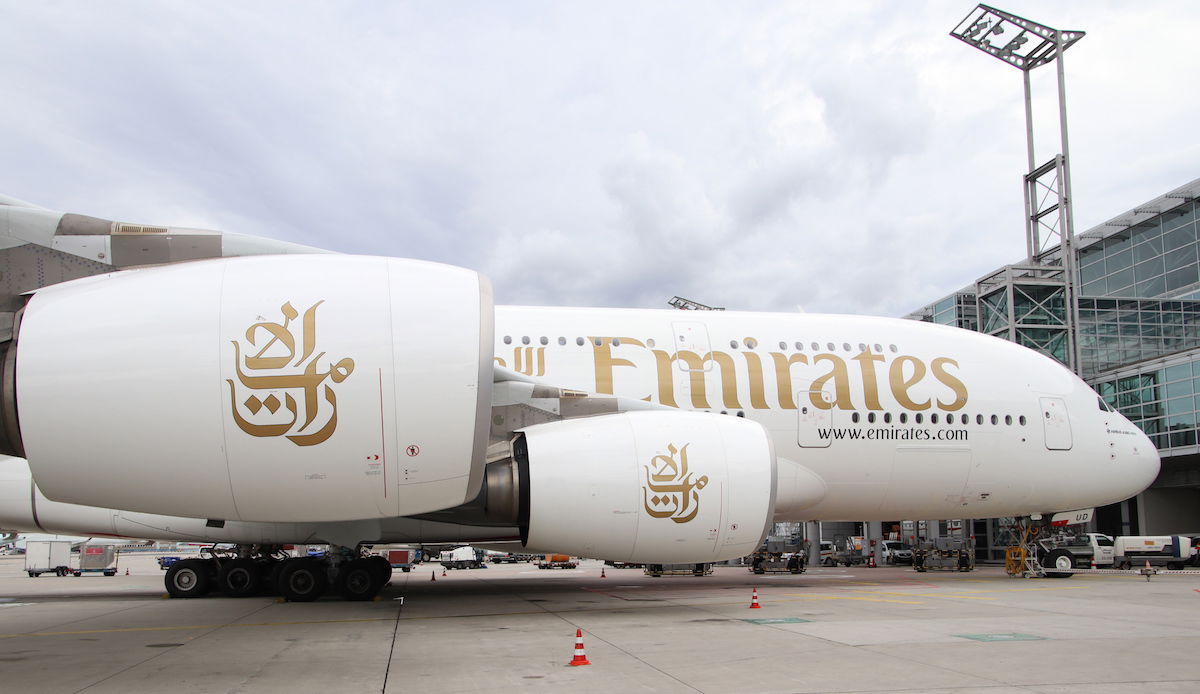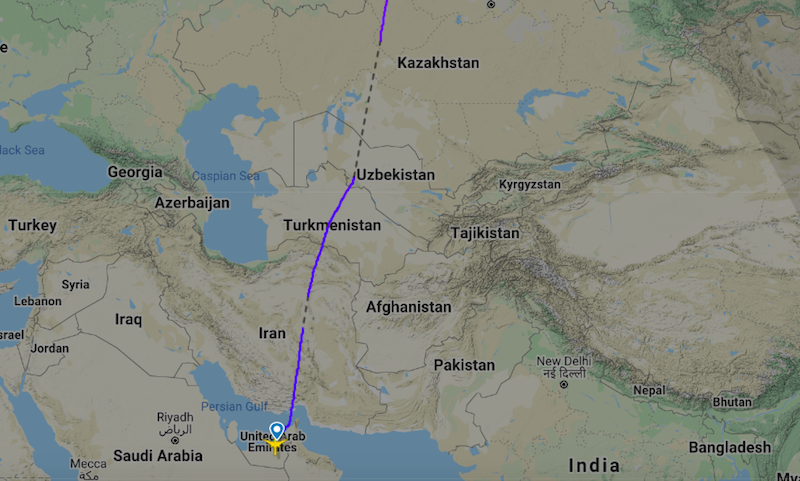Last week a Ukraine International Airlines 737-800 crashed shortly after takeoff from Tehran. Within days Iran admitted that they accidentally shot down the plane. Following all of this, some airlines have decided to suspend and/or cancel flights to Iran altogether, and many airlines have also started avoiding Iranian airspace.
Initially most Gulf carriers didn’t avoid Iranian airspace, though it looks like that is starting to change. Emirates has started avoiding Iranian airspace on many of their routes, including those to the US, and this has presented some logistical challenges.
At a minimum, some of Emirates’ flights to the US are significantly longer than usual. For example, Emirates’ flight from Dubai to Los Angeles typically takes a Polar route. Here’s what the initial route looked like before Emirates started avoiding Iranian airspace, per Flightradar24:

And here’s what it looks like now:

So yeah, now Emirates is flying East, in order to be able to fly North, in order to be able to fly South, in order to be able to fly West. Gotta love Polar routings. 😉
For example, yesterday’s flight clocked in at 16hr54min, which is about an hour longer than usual.
At least that flight has still managed to operate nonstop, which wasn’t the case for some other flights:
- Emirates’ flight from Dubai to Dallas (operated by a 777) has diverted to Stockholm the past two days to refuel
- Emirates flight from Dubai to Houston (operated by an A380) diverted to Toronto on January 13 to refuel, while yesterday it flew nonstop in a flight time of 17hr8min, which has to be some sort of a record for a nonstop Dubai to US flight
 Emirates A380
Emirates A380
This isn’t posing much of an issue for flights bound to the US East Coast, since those flights can just fly directly West, avoiding the Polar route and Iranian airspace.
For what it’s worth, Qatar Airways continues to actively use Iranian airspace. In fairness, they also have the challenge of having to avoid Saudi Arabian airspace, so their options are more limited than Emirates’.
Also interesting is that Etihad continues to use Iranian airspace, so it seems the two government owned UAE airlines are taking different approaches here. For example, below is their routing from two days ago for the Abu Dhabi to Los Angeles flight.

Bottom line
Kudos to Emirates for erring on the side of caution when it comes to using Iranian airspace, since it’s not often we see the Gulf carriers heed the warnings of international authorities.
If you are flying Emirates to the US in the coming days and weeks, certainly don’t plan a 42 minute connection after landing. 😉
While East Coast flights should mostly be fine, expect delays on flights to Texas and the West Coast. It seems the need for diversions varies by day, presumably depending on the passenger and cargo load, as well as the winds, and how much fuel they can carry.
Would you feel more comfortable taking a flight that avoids Iranian airspace, or does Iran’s admission of having shot down the plane make you feel better about using the airspace, and that the event won’t repeat itself?
(Tip of the hat to Paddle Your Own Kanoo)





Hi,
I flew Emirates Dubai - Los Angeles on Jan 20, 2020. It flew over Iraq to reach Copenhagen for refueling for an hour and took off to LA. The total time of the flight was 17.5 hours. Kudos to Emirates flight, they tried to make the passengers comfortable as much as they could.
When your time is up? No matter if you fly over or not over Iran or Iraq...We should not live in shadow of fear.
It's better to be late than never
You are all rather cavalier with the lives of others on a commercial flight over this unstable region.
Your opinions are worthless. Unless you lost a loved one!
No one should fly over this country unless a military bomber! With a payload!
They are pure evil!
Interesting analysis @Expresswayvisual
KJ,
It could be said that flying over the waters of the Persian Gulf is perhaps even more risky than flying high over the ground in some parts of Iran.
Also, this may be a time where Iran missile and AA gun battery operators are a little less trigger happy than a newly deployed US missile or gun battery operator working under a heightened alert state for a military that hasn’t as recently shot down a passenger jet as Iran has.
Caution and safety is the essence of flying, avoiding Iranian Airspace is the right way for flight out of the Gulf.
@Shaun - Sorry for getting a bit technical, but there are some technicalities of the situation that can only be expressed, well, technically!
In English, my comment is that, in my view there are some (many) parts of Iraqi airspace where the risk of operations are significantly higher than in some parts of Iranian airspace. Furthermore, the US FAA has also restricted operations in most of Bahrain airspace as well as some parts of...
@Shaun - Sorry for getting a bit technical, but there are some technicalities of the situation that can only be expressed, well, technically!
In English, my comment is that, in my view there are some (many) parts of Iraqi airspace where the risk of operations are significantly higher than in some parts of Iranian airspace. Furthermore, the US FAA has also restricted operations in most of Bahrain airspace as well as some parts of Oman airspace, unique among most advisories and restrictions in the region. That is likely due to perceived risks specific to US registered aircraft in those areas rather than a general concern about safety for other operators. All safety advisories and risk evaluations are not the same, so to apply one set of standards to a situation that it was not intended to apply to, is not likely to generate appropriately contextual results.
Nonetheless, for someone to believe that flying on one side of an imaginary line in the sky ostensibly belonging to Iran is "unsafe", while flying just a few miles away on a similar path in a part of the sky ostensibly belonging to Iraq or Turkey or any other country is "safe" is not a reasonable belief. It is likely tinted by politics rather than an objective assessment of the actual risks.
@sean
Excellent! Now if you could regale us with a translation in the English language, for we are mere benighted simpletons.
My booked Europe-Dubai flights for today have been routing via the Sinai/Egypt and then something like along the Jordan-Saudi Arabia border or otherwise into Saudi Arabia and onward to Dubai.
LX has also done this kind of thing.
I am about to board a Qatar Flight to PHL in about 10 mins , and to be quite honest I was terrified at first but considering these Gulf Airlines are all premium carriers , and have very few aviation disasters , I think it’s safe to say they know what they are doing !!
Hi All,
I will fly from Zurich to Dubai soon. I am a bit concerned what airspace Swiss will fly this route. If any of you has knowledge, please give me advice. I don't want to cancel my trip if not necessary. Thank you all.
@Sean M
FIR. N-reg. M628. OOM FIR. OIIE. OO OO AAHH AAHH
Sean,
No but if they send off a missile they're far more likely to be targeting targets close in (over their territory) than something further away, over other territory.
have a look at the route El Al flight 072 from Mumbai to Tel Aviv takes; on Flight Tracker it looks much the same as if it was a ship at sea
@Tim - Nothing stops a rogue state player from firing missiles at aircraft outside their FIRs either. It's not like Iranian missiles suddenly lose their potency as they cross the border with Iraq or Turkey.
Last time I flew QR in 2019, they used Iraqi air space for flights from the US east coast, and flew over water (Persian Gulf and Gulf of Oman to reach SE Asia, only overflying India); they do actually clip the tiny exclave of Oman instead overflying waters of the Strait of Hormuz.
Sean,
The non-political part of why Iran appears more dangerous is that in the past year they used anti aircraft missiles on two occasions. One against a US drone, another against the 737-800. Iraq did not do anything similar. This should count for something.
Doesn’t Emirates and Etihad still have flights to one or more Iranian cities?
I can’t imagine the UAE wanting to give even that business to QR.
Allowing or denying codeshares is indeed a lever of power that the US Government uses to push other countries and airlines to do what the US Government wants to get those foreign parties to do.
If they want to codeshare with B6 on the DXB to US flights, they need to avoid Iranian airspace. B6 pulled the EK codeshare until the end of month because EK kept flying through Iran. I'm sure now they can show the FAA that EK is not flying through Iran and reinstate the codeshare.
Perhaps the US now also asks/demands foreign carriers’ US-bound flights (or foreign carriers with US-bound flights?) to avoid Iranian airspace and thus further sanction Iran that way?
There is politics of course involved in this. While I may be fine with flying at high altitudes over eastern Iran, I wouldn’t want to be flying over some stretches of Iraq or Turkey on some days.
Corky,
The only parties readily capable of shooting down planes flying 20k+ feet above Afghanistan and Pakistan are military actors — military actors from states such as the US, Russia, Iran, and Pakistan ... at least three of which have shot down passenger jets in my flying lifetime and a fourth of which is the handmaiden to the Saudi government and their historical Taliban allies.
I’ve flown a huge number of times over Iranian...
Corky,
The only parties readily capable of shooting down planes flying 20k+ feet above Afghanistan and Pakistan are military actors — military actors from states such as the US, Russia, Iran, and Pakistan ... at least three of which have shot down passenger jets in my flying lifetime and a fourth of which is the handmaiden to the Saudi government and their historical Taliban allies.
I’ve flown a huge number of times over Iranian and Afghan and Pakistani airspace within the past 19-20 years at least, and the risk to those flights wouldn’t come from the Taliban firing at my planes high up in the air.
@Sean M
I don't understand anything you just wrote there, but I feel smarter after reading it. Thank you for your thorough and professional explanation.
@Ghostrider5408 - I chose my words very carefully. I have reviewed the latest risk assessment and guidance documents for the region and I have experience of managing operations within the airspace in question. I did not claim that operations within all of Tehran FIR are safe, but rather that a similar risk profile exists for operations within some parts of Baghdad FIR. To ignore one while fixating on the other is not a safety decision,...
@Ghostrider5408 - I chose my words very carefully. I have reviewed the latest risk assessment and guidance documents for the region and I have experience of managing operations within the airspace in question. I did not claim that operations within all of Tehran FIR are safe, but rather that a similar risk profile exists for operations within some parts of Baghdad FIR. To ignore one while fixating on the other is not a safety decision, but rather a political one.
Presently the FAA has restrictions on N-reg operating in Muscat FIR north of M628 - unique among other advisories. That is likely based upon an elevated risk profile specific to N-reg in that area, and not necessarily reflective of the safety of operations within OOMM FIR by other operators. Drawing lines in the sky is an inexact exercise at the best of times, so a black-and-white designation of safe and unsafe on the basis of FIR boundaries should never be taken as gospel.
Personally, I would currently be comfortable operating in certain parts of Tehran FIR at certain flight levels and along certain airways. I would not have been comfortable operating from OIIE during the recent incident window. I would have absolute comfort operating in Muscat FIR north of M628, despite the current FAA advisory (non N-reg).
Qatar, on its Doha to East coast flights has started avoiding Iranian airspace over the last few days as well.
Qatar could not operate without flying over Iran. They would be flying exclusively to Asia without using Iranian airspace.
@Christoph agreed. Actually QR had only two neighbors that they could use to get out of gulf regions (due to Arab-wide boycott led by Saudi Arabia) and they were Iran and Iraq. Only other option for QR would be to shut down its operations altogether. I expect QR to continue using Iranian and Iraqi airspace and I won't feel rhat comfy flying QR for that reason...
Frankly I disagree with Seam M there is more to a missile coming at you than politics. In a former life in the USAF I know what that feeling is and it's not pleasant. While on that subject I was shocked that there were two missiles launched and struck the 737 that makes me wonder if the second missile had not been launched maybe they would have made it back to the runway? I think...
Frankly I disagree with Seam M there is more to a missile coming at you than politics. In a former life in the USAF I know what that feeling is and it's not pleasant. While on that subject I was shocked that there were two missiles launched and struck the 737 that makes me wonder if the second missile had not been launched maybe they would have made it back to the runway? I think so from what information there is. There are two many trigger happy people in that region lacking training and discipline.
I believe that anyone who implements a blanket "ban" on Iranian airspace operations, while continuing to operate in Iraqi airspace without restriction, is acting more out of political considerations than safety ones.
I wonder why Emirates doesn’t fly to Saudi Arabia then start there polar route going north above Turkey??
Delta, United and El Al never fly in Iranian airspace
Where is the new ANA first class review? I have been waiting on that to come out.
I thought I'd linked to Etihad's website (last week?) that said they were modifying their routing to avoid Iranian airspace? Did Etihad change their mind (like they apparently have done with their "non-expiring" miles now?)
Personally, I'd much rather fly via Iranian airspace than have an hour long delay (or even longer, if refueling is needed). Change of something happening is negligible, I take far higher risks when travelling, or even walking on a street.
Is flying over Taliban-held portions of Afghanistan safer?
"For what it’s worth, Qatar Airways continues to actively use Iranian airspace. In fairness, they also have the challenge of having to avoid Iranian airspace, so their options are more limited than Emirates’." I think this shouldn't read Iranian airspace the second time, but UAE airspace, etc.